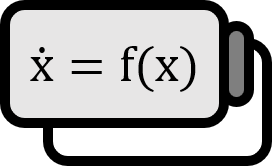Conservation Quantities of Autonomous Systems
Definition
Let’s assume that we have a vector field given by a differential equation related to a space $X$ and a function $f : X \to X$. $$ \dot{x} = f(x) $$ If there exists a constant function $h : X \to \mathbb{R}$ that is dependent on the given system, it is called a conservation quantity.
Explanation
If one is familiar with the mechanical sense in physics, the concept of conservation quantity is not at all unfamiliar. For example, in the ideal case where a ball is shot upwards against the vertical direction, the sum of the kinetic energy and potential energy of the ball remains constant. Approaching this mathematically, i.e., dynamically, it is equivalent to the existence of a constant function dependent on the system.
Classical Mechanics Model1
$$ \begin{align*} \dot{x} =& y \\ \dot{y} =& x - x^{3} - \delta y \qquad , \delta \ge 0 \end{align*} $$ Consider a non-forced damped oscillator. If $x$ is considered as the position of a particle, then $y$ would be the velocity, and $y '$ would be the acceleration. Thus, in the differential equation, the damping term $-\delta y$ describes the force acting in the opposite direction of movement, proportional to the speed. Due to such action, the particle gradually loses energy and will eventually stop. Most physical phenomena in the real world, like this, cannot move indefinitely due to friction or damping. Now, let’s perform a thought experiment assuming an ideal situation where no damping occurs, $\delta = 0$. If we unify the characters to $x$ $$ \ddot{x} = x - x^{3} - 0 x' $$ Multiplying all terms by $\dot{x}$ and moving them to the left side to rearrange yields $$ \dot{x} x’’ - \dot{x} x + \dot{x} x^{3} = 0 $$ If we consider that each term has been differentiated by $\displaystyle {{ d } \over { d t }}$, then $$ {{ d } \over { d t }} \left( {{ 1 } \over { 2 }} (x’)^{2} - {{ x^{2} } \over { 2 }} + {{ x^{4} } \over { 4 }} \right) = 0 $$ As the right side equals $0$, the following constant function $h(x,y)$ can be derived. $$ h(x,y) := {{ y^{2} } \over { 2 }} - {{ x^{2} } \over { 2 }} + {{ x^{4} } \over { 4 }} $$ If the mass of the body is $m=1$, then $\displaystyle {{ 1 \cdot y^{2} } \over { 2 }}$ is the kinetic energy, and if $\displaystyle {{ x^{4} } \over { 4 }} - {{ x^{2} } \over { 2 }}$ is the potential energy, then $h$ can be seen as a constant conservation quantity, which also represents the total amount of energy.
Disease Spread Model2
Although it is very intuitive to introduce the concept of conservation quantity with systems in mechanics, there’s no need to solely think of its physical meaning when explaining conservation quantities defined by functions. For example, consider the following system. $$ \begin{align*} {{ d S } \over { d t }} =& - {{ \beta I S } \over { N }} \\ {{ d I } \over { d t }} =& {{ \beta I S } \over { N }} - \gamma I \\ {{ d R } \over { d t }} =& \gamma I \end{align*} $$ Here, $N$ is the total population, $S$ is the population that can be infected, $I$ is the population spreading the disease, $R$ is the population with immunity, which makes this model known as the SIR model. In this case, the sum of $S, I, R$ must be $N$. Hence, in this case, the conservation quantity will be $N$, which is the sum of all states. $$ h(S,I,R) = S + I + R = N $$ Though this might seem too obvious and hence irrelevant, the point is to think flexibly about whether the conservation quantity is important or not. Moreover, not checking such simple things in modeling may lead to big errors, so it’s definitely better to be aware of them.
